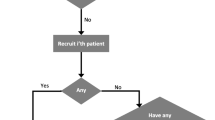Abstract
Cohort-based enrollment can slow down dose-finding trials since the outcomes of the previous cohort must be fully evaluated before the next cohort can be enrolled. This results in frequent suspension of patient enrollment. The issue is exacerbated in recent immune oncology trials where toxicity outcomes can take a long time to observe. We propose a novel phase I design, the probability-of-decision toxicity probability interval (PoD-TPI) design, to accelerate phase I trials. PoD-TPI enables dose assignment in real time in the presence of pending toxicity outcomes. With uncertain outcomes, the dose assignment decisions are treated as a random variable, and we calculate the posterior distribution of the decisions. The posterior distribution reflects the variability in the pending outcomes and allows a direct and intuitive evaluation of the confidence of all possible decisions. Optimal decisions are calculated based on 0-1 loss, and extra safety rules are constructed to enforce sufficient protection from exposing patients to risky doses. A new and useful feature of PoD-TPI is that it allows investigators and regulators to balance the trade-off between enrollment speed and making risky decisions by tuning a pair of intuitive design parameters. Through numerical studies, we evaluate the operating characteristics of PoD-TPI and demonstrate that PoD-TPI shortens trial duration and maintains trial safety and efficiency compared to existing time-to-event designs.

Similar content being viewed by others
References
Boag JW (1949) Maximum likelihood estimates of the proportion of patients cured by cancer therapy. J Roy Stat Soc Ser B (Methodol) 11(1):15–53
Chen SX, Liu JS (1997) Statistical applications of the Poisson-binomial and conditional Bernoulli distributions. Stat Sin 7(4):875–892
Cheung YK, Chappell R (2000) Sequential designs for phase I clinical trials with late-onset toxicities. Biometrics 56(4):1177–1182
Cheung YK, Chappell R (2002) A simple technique to evaluate model sensitivity in the continual reassessment method. Biometrics 58(3):671–674
Guo W, Wang SJ, Yang S, Lynn H, Ji Y (2017) A Bayesian interval dose-finding design addressing Ockham’s razor: mTPI-2. Contemp Clin Trials 58:23–33
Guo W, Ji Y, Li D (2019) R-TPI: Rolling toxicity probability interval design to shorten the duration and maintain safety of phase I trials. J Biopharm Stat 29(3):1–4
Ivanova A, Flournoy N, Chung Y (2007) Cumulative cohort design for dose-finding. J Stat Plan Inference 137(7):2316–2327
Jefferys WH, Berger JO (1992) Ockham’s razor and Bayesian analysis. Am Sci 80(1):64–72
Ji Y, Wang SJ (2013) Modified toxicity probability interval design: a safer and more reliable method than the 3+3 design for practical phase I trials. J Clin Oncol 31(14):1785–1791
Ji Y, Li Y, Nebiyou Bekele B (2007) Dose-finding in phase I clinical trials based on toxicity probability intervals. Clin Trials 4(3):235–244
Ji Y, Liu P, Li Y, Nebiyou Bekele B (2010) A modified toxicity probability interval method for dose-finding trials. Clin Trials 7(6):653–663
Kanjanapan Y, Day D, Butler M, Wang L, Joshua A, Hogg D, Leighl N, Razak AA, Hansen A, Boujos S, Chappell M, Chow K, Sherwin B, Stayner LA, Soultani L, Zambrana A, Siu L, Bedard P, Spreafico A (2019) Delayed immune-related adverse events in assessment for dose-limiting toxicity in early phase immunotherapy trials. Eur J Cancer 107:1–7
Klein JP, Moeschberger ML (2006) Survival analysis: techniques for censored and truncated data. Springer, New York
Lee SM, Cheung YK (2009) Model calibration in the continual reassessment method. Clin Trials 6(3):227–238
Lin R, Yuan Y (2018) Time-to-event model-assisted designs to accelerate phase I clinical trials. arXiv preprint arXiv:180708393
Liu M, Wang SJ, Ji Y (2019) The i3+3 design for phase I clinical trials. arXiv preprint arXiv:190101303
Liu S, Yuan Y (2015) Bayesian optimal interval designs for phase I clinical trials. J R Stat Soc Ser C (Appl Stat) 64(3):507–523
Mossé YP, Lim MS, Voss SD, Wilner K, Ruffner K, Laliberte J, Rolland D, Balis FM, Maris JM, Weigel BJ, Ingle AM, Ahern C, Adamson PC, Blaney SM (2013) Safety and activity of crizotinib for paediatric patients with refractory solid tumours or anaplastic large-cell lymphoma: a children’s oncology group phase 1 consortium study. Lancet Oncol 14(6):472–480
Normolle D, Lawrence T (2006) Designing dose-escalation trials with late-onset toxicities using the time-to-event continual reassessment method. J Clin Oncol 24(27):4426–4433
O’Quigley J, Pepe M, Fisher L (1990) Continual reassessment method: a practical design for phase 1 clinical trials in cancer. Biometrics 46(1):33–48
Skolnik JM, Barrett JS, Jayaraman B, Patel D, Adamson PC (2008) Shortening the timeline of pediatric phase I trials: the rolling six design. J Clin Oncol 26(2):190–195
von Stackelberg A, Locatelli F, Zugmaier G, Handgretinger R, Trippett TM, Rizzari C, Bader P, O’brien MM, Brethon B, Bhojwani D, Schlegel PG, Borkhardt A, Rheingold SR, Cooper TM, Zwaan CM, Barnette P, Messina C, Michel G, DuBois SG, Hu K, Zhu M, Whitlock JA, Gore L (2016) Phase I/phase II study of blinatumomab in pediatric patients with relapsed/refractory acute lymphoblastic leukemia. J Clin Oncol 34(36):4381–4389
Storer BE (1989) Design and analysis of phase I clinical trials. Biometrics 45(3):925–937
Yan F, Mandrekar SJ, Yuan Y (2017) Keyboard: a novel Bayesian toxicity probability interval design for phase I clinical trials. Clin Cancer Res 23(15):3994–4003
Yuan Y, Lin R, Li D, Nie L, Warren KE (2018) Time-to-event Bayesian optimal interval design to accelerate phase I trials. Clinical Cancer Research Article No. 0246
Author information
Authors and Affiliations
Corresponding author
Electronic supplementary material
Below is the link to the electronic supplementary material.
Rights and permissions
About this article
Cite this article
Zhou, T., Guo, W. & Ji, Y. PoD-TPI: Probability-of-Decision Toxicity Probability Interval Design to Accelerate Phase I Trials. Stat Biosci 12, 124–145 (2020). https://doi.org/10.1007/s12561-019-09264-0
Received:
Revised:
Accepted:
Published:
Issue Date:
DOI: https://doi.org/10.1007/s12561-019-09264-0




